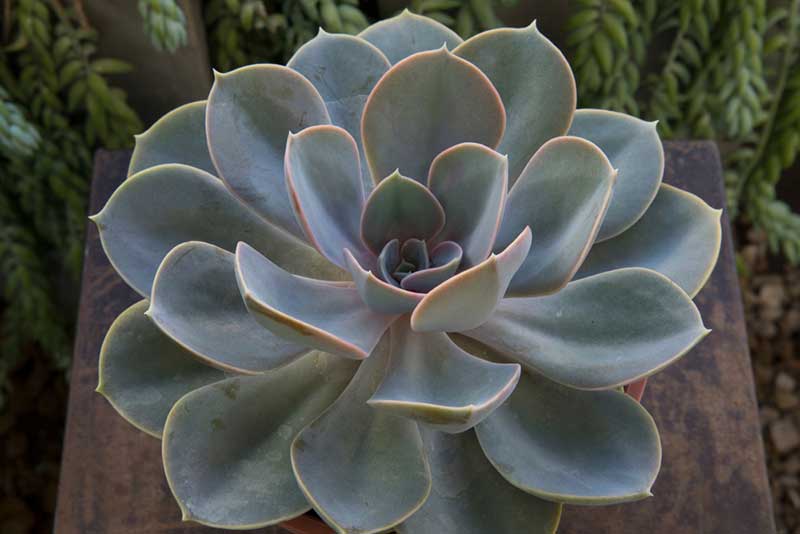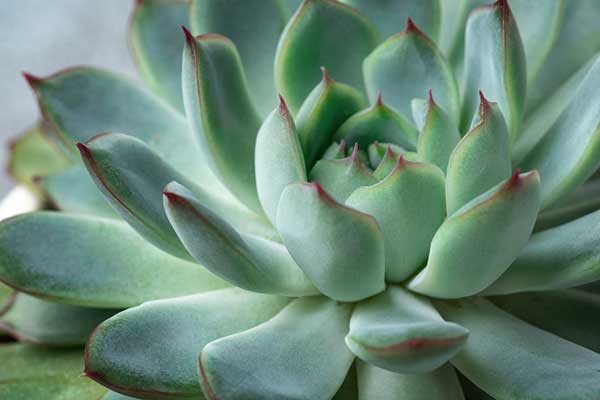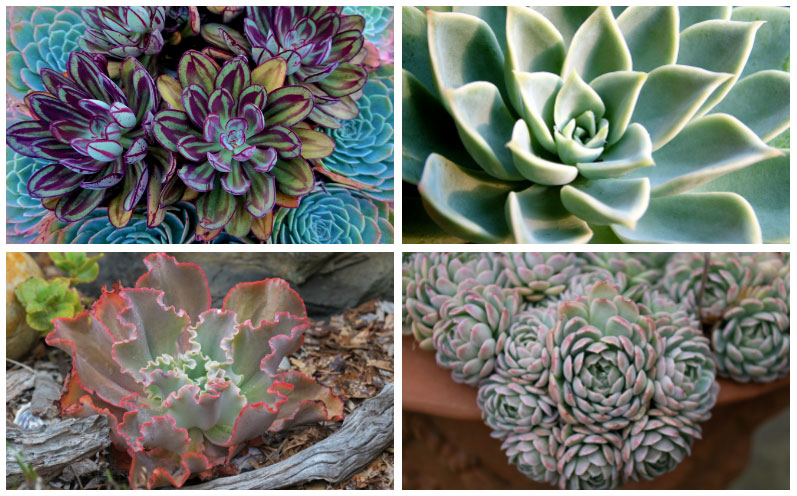
Echeveria succulents include over 150 species, but they all have similar traits. These adorable little succulents form a rosette of fleshy leaves that resemble a flower and range in color from deep green, blue-green or gray-green to rosy hues.
Many feature green leaves with contrasting colors on the tips.
Sometimes referred to as hens ‘n chicks, echeveria succulents develop tiny offsets at the base that grow into an identical plant as the parent.
Light and Temperature Requirements
Echeverias prefer a sunny location that receives 6 to 8 hours of direct sunlight a day, but they are susceptible to the harsh afternoon sun in hot climates. The tender leaves will burn and scar if exposed to the harsh rays of the summer sun in southern climates. For best results, provide your echeveria with some shelter from the afternoon sun when you are growing them outside.
Likewise, use caution when moving echeverias that you have overwintered inside to their outside location. Do so gradually by placing the pot in morning sun for an hour or two and gradually increase the exposure to noonday and afternoon sun. A drastic change in sun exposure can damage your plants.

For echeverias grown as houseplants (or those being overwintered inside the home), place them near a sunny window where they will receive full sun. A western or southern window is best, especially in northern climates where the days are short in the winter and getting enough sun for sun-loving plants can be a challenge.
Echeverias are typically hardy to 40 to 45 degrees and thrive in USDA plant hardiness zones 9 through 11, but there are exceptions. Always check the plant label for the plant’s hardiness zone.
Watering
Like other succulents, echeveria is efficient at using water and does not require frequent watering. It does however, require consistent watering. The best way to water your echeveria is to water the soil (not the rosette) until water runs through the bottom of the pot. Repeat the process two or three times and then make sure the saucer beneath the pot is empty. Allow the soil to dry out before watering the plant again.
Use the health of your plant (and dryness of the soil) as your guide to when it needs water. Many factors, such as the size of the container, the growth rate of the plant and the weather conditions all affect how frequently your echeveria will need to be watered. As a rule, plants also need more frequent watering from spring until fall and require less during the winter when growth is at its slowest.
Soil & Fertilizing
All purpose potting soil is too heavy and dense for succulents as they require sandy or gritty, well-draining soil. You can buy commercial cactus and succulent soil mixes nearly anywhere plants and gardening supplies are sold, but you can also make your own.
Mix equal parts all-purpose potting soil, builder’s sand and perlite to make a homemade potting mixture for your echeveria. It is important to note that you must use coarse or builder’s sand in the mixture as fine sand can clog the pores in the soil and prevent drainage.
These plants have adapted to growing in poor soil making their roots susceptible to damage from fertilizer. If you choose to fertilize your echeveria plants, use a succulent or cactus fertilizer mixed to 1/4 strength and apply it to the soil just after watering the plant. A once a year application in the spring is typically sufficient.
Deadheading and Pruning
Echeveria plants are typically grown for their attractive flower-like foliage, but they often bloom, too. The flowers appear atop arched stalks that can reach a height of 12 inches. The showy blooms open one at a time to reveal aster-like petals in shades of pink or red. Removing the faded blooms will improve the appearance of your plant.
Otherwise, echeveria does not require pruning.
Propagation
Propagating echeveria to grow new plants is easy because the plant does most of the work for you. Tiny offsets form around the base of the rosette and grow into new plants on their own. While many prefer to let them reproduce naturally and grow into a cluster of plants, you can remove and root the offsets and pot them up in new pots. Here’s how.
- Fill a flat or container with slightly moist cactus potting mix.
- Gently remove the offset at the base of the rosette. If it resists your efforts, you can clip it free of the plant.
- Place the offset in the soil and place it in an area with bright, indirect light to root.
- Water it when the soil dries and watch for new growth to appear. Alternately, gently tug on the offset in 10 to 14 days. If it resists your efforts, roots have formed.
- Resume normal care.
You can also propagate echeveria via stem cuttings following the same procedure. Simply remove a leaf from the rosette and pot it in cactus media. You can stand it upright or lay it on its side, and it will soon develop new roots.
Echeveria succulents make excellent additions to dish gardens, terrariums or as part of a succulent collection, but they can be delightful in the garden, too. Always check the hardiness zone for the variety you are choosing to ensure it is safe to grow in your zone. Otherwise, grow them in containers and move them inside for the winter.






